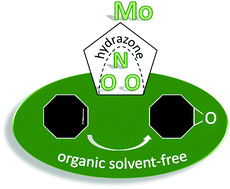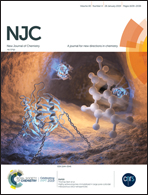Discrete mononuclear and dinuclear compounds containing a MoO22+ core and 4-aminobenzhydrazone ligands: synthesis, structure and organic-solvent-free epoxidation activity†
Abstract
Cyclic dinuclear molybdenum(vi) complexes [MoO2(L1–3)]2 (1, 2-α, 2-β and 3) were synthesized through the use of coordination-driven self-assembly of a MoO22+ core and 4-aminobenzoylhydrazone ligands (salicylaldehyde (H2L1), 3-methoxysalicylaldehyde (H2L2) or 4-methoxysalicylaldehyde 4-aminobenzoylhydrazone (H2L3)). Their X-ray diffraction (XRD) analysis revealed that these types of ligands could serve as organic linkers for cis-octahedral complexes containing a MoO22+ core. Mononuclear complexes [MoO2(L1–3)(MeOH)] (1a–3a) and [MoO2(L1–3)(EtOH)] (1b, 2b-α, 2b-β and 3b) were also obtained. In the presence of strong donors, such as dmf, ligand substitution occurred and the structures of 1–3 changed into [MoO2(L1)(dmf)] (1c), [MoO2(L2)(dmf)] (2c) and [MoO2(L3)(H2O)]·dmf (3c·dmf), respectively. The dioxidomolybdenum(VI) complexes were tested for catalytic epoxidation of cyclooctene under eco-friendly reaction conditions by using aqueous tert-butyl hydroperoxide (TBHP) as an oxidant without the addition of an organic solvent. The present study showed much better activity of the dinuclear catalysts than the mononuclear ones due to the weak donor properties of the amino group and high geometric constraints occurring in such small sized self-assembled systems as confirmed by density functional theory calculations.



 Please wait while we load your content...
Please wait while we load your content...